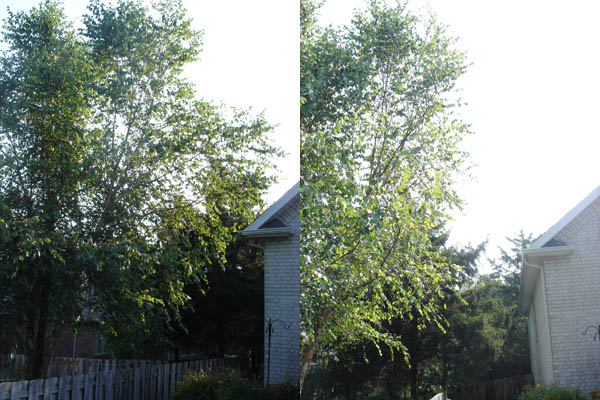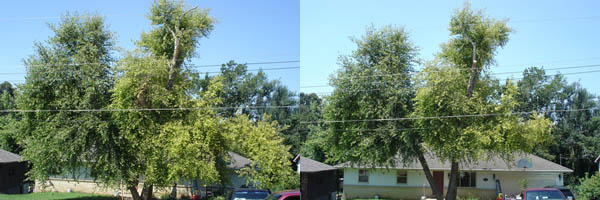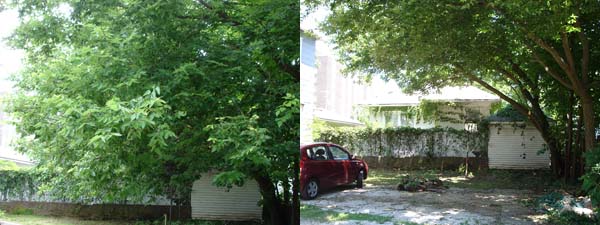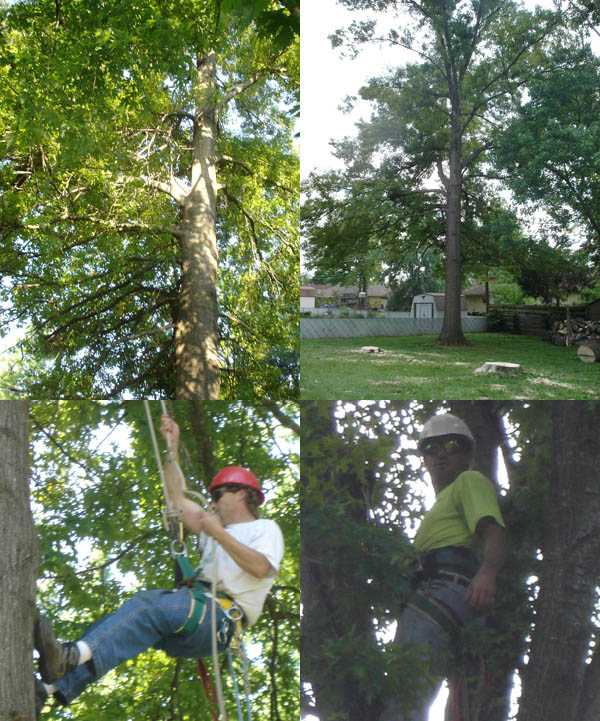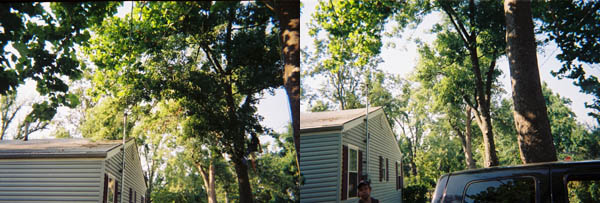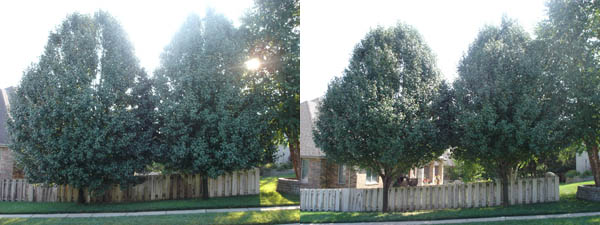Spikeless Tree Trimming

When you choose Tree Solutions to trim your trees, you can rest easy with total confidence. We will never leave your tree looking like a hatrack, or a totem pole, and we won’t leave a trail of spike gouges all over the tree.
We will leave your trees looking great. We make good cuts, in the right locations. We remove less than 25% of the tree’s foliage. And we use advanced climbing techinques to access the canopy, so we don’t make any wounds other than the actual cuts.
Spikes leave wounds on your tree, making them susceptible to insects and bacterial or fungal infections. We climb without spikes, to help insure the health and beauty of your tree.
The location of pruning cuts will be carefully selected, and the cuts themselves will be in the correct spot, at the correct angle for the health of the tree, and to make the tree’s sealing response as efficient as possible.
Tree Trimming Options:
Crown Cleaning: Taking out the dead wood helps minimize potential danger and liability, and allows the tree to seal over the wound created when the limb dies. Removing broken or crossing limbs will improve the tree’s structure and safety.
Crown Thinning: Is selective removal of small branches throughout the canopy. Crown thinning lessens wind, ice, and snow loads, which reduces the possibility of limb breakage, trunk failure, and uprooting. Crown thinning also allows more light to reach the lower levels and ground. Knowing which branches to thin (and why) is critical to a beautifully thinned tree.
Crown reduction: Is an alternative to tree topping. While crown reduction trimming is still harmful to the tree, it is much better than topping. Proper crown reduction cuts are made leaving properly sized lateral limbs as the new terminal tops and branches. Crown reduction can reduce the height, spread, or both of a too tall or too wide tree.
Crown Raising: Removal of lower branches to allow clearance under your trees. It should be noted that raising the crown opens the tree to potential damage from soil compaction, mowers and weedeaters. Critical root zone mulching can help avoid these problems. Removal of large low branches on a mature tree is harmful, and could allow the trunk to rot and become hollow.
Target Specific Pruning: In many cases one or two branches are causing damage to a structure, and need to be pruned. Making a good decision about where and how to reduce the offending limb are important to ongoing tree health and beauty.
Formative Pruning: Generally practiced on young trees to help them grow with proper structure and strong junctions. Proper pruning on young trees can do much to reduce danger and expense as a tree grows in size and mass.
Crown restoration pruning: Helps restore storm damaged trees, poorly trimmed trees or topped trees to a natural shape once again. Restoring a tree damaged by man or nature takes a few years, but the shape and beauty of your tree can be restored with proper care and time. Unfortunately, not every damaged tree can be restored. In some cases removal and replanting is the only remaining option.
When to have your trees trimmed?
Most trees can be trimmed any time of the year, however there are a couple exceptions.
Trees in the Elm family and trees in the Red Oak family should only be trimmed when dormant to minimize the chances of contracting Dutch Elm Disease and Oak Wilt.
Trees should not be trimmed when they first leaf out in the spring, and for at least 30 days afterward. This is because the tree has just spent alot of energy to grow it’s canopy of leaves, and it needs to re-coop some of that energy from the photosynthesis of the leaves. The tree cannot regain that energy if the new leaves are cut off.
Pin Oak crown cleaning
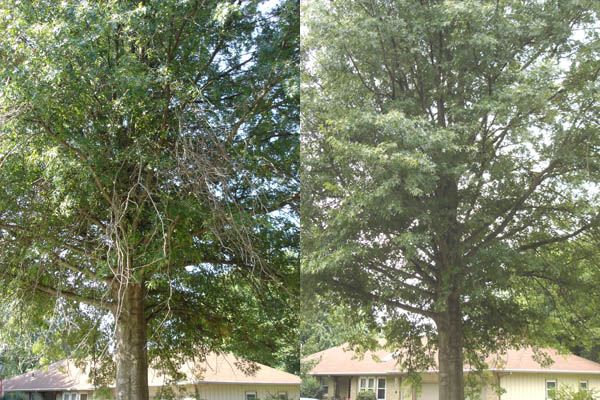
Here is a Pin Oak tree before and after crown cleaning. Pin Oak’s are in the Red Oak family, and should not have live limbs trimmed during the growing season to minimize the possibility of Oak Wilt. Only dead limbs were removed in this crown cleaning. Now no dead limbs pose a danger of falling, and the tree has a much improved appearance. As always, all our tree trimming and pruning is performed using spikeless tree climbing techniques.
Bradford Pear crown reduction
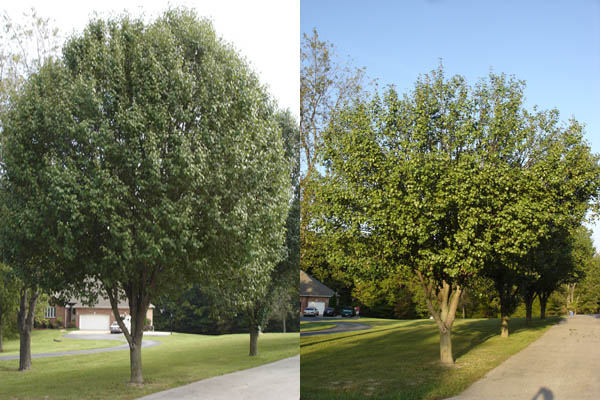
This medium sized Bradford Pear was crown reduced to help prevent ice damage and wind damage. This species is genetically predisposed to self destruction, mostly because they form weak crotches all at one point on the trunk, and their wood is brittle. This is a proper crown reduction, with each reduced limb cut to a 1:3 lateral. This type of trimming will result in much less sprout growth and a more natural form than topping or rounding over.
River Birch crown raise
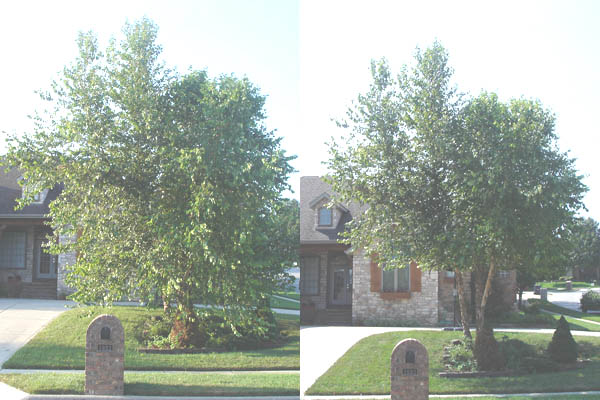
This young multi-stem River Birch was hanging too low to care for the landscaping, so it’s crown was raised, and a few long limbs were lightly pruned back to proper laterals. It now compliments and highlights the landscaping in front of the house.
River Birch roofline clearance
This River Birch’s limbs were hanging over and laying on top of the neighbors house. They were trimmed back to the trunk or proper laterals as each limb needed. The birch tree still looks natural, but now is well clear of the house.
River Birch crown raise & deadwood
This River Birch, or Red Birch had two tops which died back due to improper trimming (probably as the result of ice damage), and alot of small branches and foliage hanging too far down. The dead wood was trimmed without spikes, and the hanging limbs were pruned to proper laterals.
Red Maple, Hackberry & Mulberry trims
Here we have a Hackberry, a Red Maple, and a Mulberry tree, all three trees were overgrown to the point that this parking area was unusable. All were all trimmed without spikes, and they now shade a once again usable parking area and yard.
Pin Oak damage and deadwood trim
This large pin oak had alot of hung up ice storm damage in it’s crown, more even than can be seen in the before picture. Several heavy limbs were broken over 3 low voltage service lines and a chain link fence.
Both Brian and Dean climbed and worked in this big tree. As always, trim jobs are done spikeless. We don’t ever leave a spike trail up your trees. All the breakage was successfully removed with no damage to anything.
Easily visible is the bare side of the tree, where no limbs got enough light to grow due to the competing Silver Maples which were removed. Over time the Pin Oak will fill in some, but it’s unlikely that it will catch up to the older growth.
This Pin Oak, like all Oaks in the Red Oak family should be trimmed/pruned when dormant, to minimize the possibility of Oak Wilt, however the homeowner’s main concern was damage from falling limbs.
left: Brian Weatherford ascending the trunk spikeless.
right: Dean Hudson in the crown, stil six feet to go to get to the last broken limb, also spikeless.
Silver Maple roofline clearance
This Silver Maple had limbs laying on the roof, trapping moisture, and growing toward the weatherhead. The tree was climbed without spikes, and the offending limbs removed. They were trimmed to laterals, to help minimize the sprouting response, and seal the wounds over.
Bradford Pears crown raise
These two Bradford Pear trees were blocking the sidewalk, and causing difficulties in maintaining the yard, so they were crown raised slightly, and some conflicting interior growth was removed to improve their structure and future growth.

